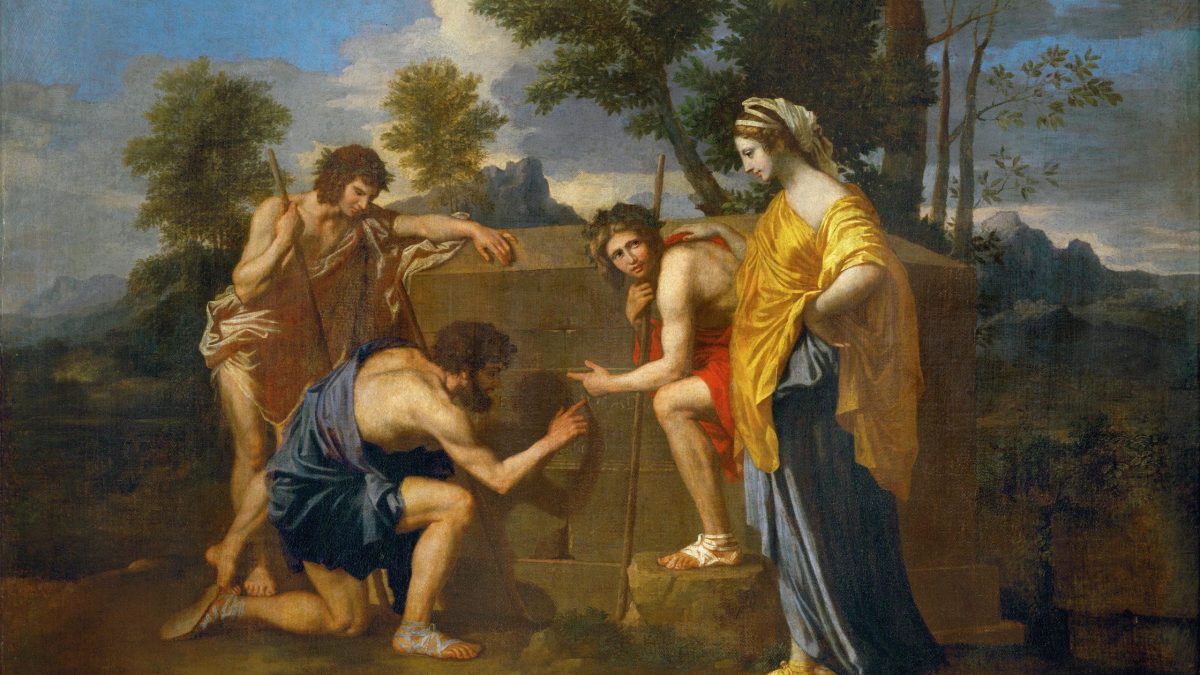The vast strangeness of plants—close to Freudian uncanniness—displays itself both under sunlight and in the shadows. The contrast between open meadows and shady woods, or between barren heath and bountiful forests, are literary commonplaces: where the contrast of light and darkness plays a founding role. Indeed, some qualities of the vegetal world (at least as it is conceived of in Western culture) are similar to those of darkness. Both are very close to human life, yet both are harshly opposed to such life. Plants and darkness, then, involve an atmosphere: polymorphous, ubiquitous as it may be … In the words of Prudence Gibson and the other editors of Dark Botany: The Herbarium Tales (Open Humanities Press, 2024): “To say the word ‘plant’ seems to open onto … abyssal non-knowledge and non-identity.”
Even under the most amiable luminosity, darkness may be lurking within vegetation. Consider Nicolas Poussin’s famous Et in Arcadia ego paintings (1627–38): here, a tomb—half hidden in the foliage of a bucolic retreat—summons death to the scene. Or take the film Blue Velvet, by David Lynch (1986): where a scorched, freshly cut human ear—found in a field of grass—hints at a perverse, gloomy plot.
Gibson et al. speak of a “dark botany”—following the “dark ecology” of Timothy Morton—and quote him to explain that its darkness emerges as a reflexive mode of counter-narrative form and function. It is a means of owning up to the violence, erasure and oppression of plants by humans. It is a process of acknowledging the ill-effects of colonial pursuits. It is also a project of re-collecting and re-configuring our relation to the plant world’s “dark shimmering.”
Here, then, the vegetal provides a clearer understanding of the complex values of darkness. After all, darkness often appears as a solely obscure and secondary trait of modernity; but, in truth, darkness impregnates and bolsters so densely modernity’s creative powers.
A recurrent thread of modern Western sensibilities is an attraction and infatuation with “darkness,” the power of the shadows. This directly contrasts the modern hegemonic emphasis on light, characteristic of the philosophical and scientific revolution that came to be known as the Enlightenment. Merriam-Webster gives five meanings for “Darkness” (as well as for “‘Stygian,’ ‘Umbra,’ and Other Words for Darkness”): absence of light, a color or shade, a sad or depressive state, evil, the prevalence of ignorance.
Romantic imagination frequently praised the tenebrous aspects of current life, or the gloomy prospects for a future in this or another world. Likewise, the contemporary imagination—in the areas of science fiction, pop-culture sagas, ecological crisis, and art—have intensely developed the ethics and the aesthetics of a somber human condition: engulfed by the trappings of evil, damned by the prospect of an impending death, ever ready for doom, ever fearful of apocalypses.
As in most moral topics, there is plenty of room for imprecision, ambiguity, and ambivalence—the chiaroscuro effect of tenebrism. Still, today, darkness expresses a mood, an atmosphere—polymorphous and ubiquitous as it may be—that attends to things to come, and does so in a melancholy or apocalyptical key.
Once, romanticism praised darkness through doom, evil, death, and apocalypses. Today, however, such romanticism has been curbed, in a practical level, toward an enrichment of actual human life…
Gibson’s Dark Botany: The Herbarium Tales comprises 27 inspiringly varied texts. And, in so doing, the collection truly contains both ethical and moral dimensions.
On one side, there is the dark history of plant diffusion and exploitation in the worldwide colonial enterprise (including the less known history of plant intoxication in those contexts). Such a dark history ethically denounces the past (and enduring) political sins of slavery and colonial violence. Plants are a key index of nature’s destruction, the collection hints, given their massive presence (or growing absence) in human ecumene, and their immediate participation in the regimes of air, rain, health, and energy—major players in the gloomy prospects of the Anthropocene.
On the other side, there is the moral denunciation of the rational reduction of Indigenous knowledge. Such a reduction was achieved, of course, by universalistic endeavours like scientific taxonomy and collecting; hence the “herbarium tales” of the subtitle. Against the reduction are invoked “the plant’s sense of co-existence and inter-relationality” and their “constant process of deterritorialization and reterritorialization.”
The ethical denunciation follows the contemporary revision of the ominous heritage of Western occupation of the planet, in what has been called the decolonialist movement. The moral denunciation follows contemporary romantic and vitalist dispositions to praise all that recognizes and strengthens the force of life—its pristine authenticity, essential identity and expressive sensibility—against the realm of representation and rationality. The ontological turn and the interest in multispecies studies are close to the present collection’s gist, in this privileging of immediate embodied life against mediated intellectual concerns.
Darkness—opposed to Enlightenment in its best romantic guise—may bring forth “a kind of freedom,” according to nature and art specialist Giovanni Aloi, far from the constraints of universal reason applied to the human future. Aloi writes how there is “a leap into the darkness of being that separates human from non-human. However, this leap relies on the knowledge that such darkness is not a negative space—as in the conception of the Enlightenment—but co-produced by and productive of a kind of freedom.” In highlighting this leap into dark freedom, Aloi champions unsuspected ways of life: distant and discrepant from past models, inherited from the centuries-long and painfully deceptive path of enlightened applied reason.
Once, romanticism praised darkness through doom, evil, death, and apocalypses. Today, however, such romanticism has been curbed, in a practical level, toward an enrichment of actual human life: exorcizing the stifling effect of accumulative reason, and enabling a perception and fruition of a world full of shades, doubts, nuances, provisos, surprises, and wonders. Art—cultivated in the second part of Dark Botany in connection with plants and herbaria—is the best witness to darkness as revelation: ex fumo dare lucem. … ![]()
This article was commissioned by Matthew Wolf-Meyer.
Featured image: Et in Arcadia Ego by Nicolas Poussin.



